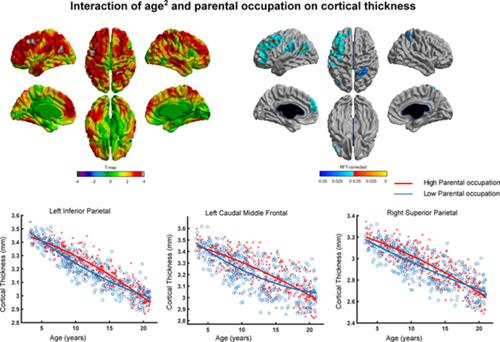当前位置:
X-MOL 学术
›
Hum. Brain Mapp.
›
论文详情
Our official English website, www.x-mol.net, welcomes your
feedback! (Note: you will need to create a separate account there.)
Distinct influence of parental occupation on cortical thickness and surface area in children and adolescents: Relation to self‐esteem
Human Brain Mapping ( IF 3.5 ) Pub Date : 2020-10-15 , DOI: 10.1002/hbm.25169 Budhachandra Khundrakpam 1, 2 , Suparna Choudhury 3 , Uku Vainik 4 , Noor Al-Sharif 1 , Neha Bhutani 1 , Seun Jeon 1 , Ian Gold 3 , Alan Evans 1, 2
Human Brain Mapping ( IF 3.5 ) Pub Date : 2020-10-15 , DOI: 10.1002/hbm.25169 Budhachandra Khundrakpam 1, 2 , Suparna Choudhury 3 , Uku Vainik 4 , Noor Al-Sharif 1 , Neha Bhutani 1 , Seun Jeon 1 , Ian Gold 3 , Alan Evans 1, 2
Affiliation

|
Studies of socioeconomic disparities have largely focused on correlating brain measures with either composite measure of socioeconomic status (SES), or its components—family income or parental education, giving little attention to the component of parental occupation. Emerging evidence suggests that parental occupation may be an important and neglected indicator of childhood and adolescent SES compared to absolute measures of material resources or academic attainment because, while related, it may more precisely capture position in social hierarchy and related health outcomes. On the other hand, although cortical thickness and surface area are brain measures with distinct genetic and developmental origins, large‐scale neuroimaging studies investigating regional differences in interaction of the composite measure of SES or its components with cortical thickness and surface area are missing. We set out to fill this gap, focusing specifically on the role of parental occupation on cortical thickness and surface area by analyzing magnetic resonance imaging scans from 704 healthy individuals (age = 3–21 years). We observed spatially distributed patterns of (parental occupation × age2) interaction with cortical thickness (localized at the left caudal middle frontal, the left inferior parietal and the right superior parietal) and surface area (localized at the left orbitofrontal cortex), indicating independent sources of variability. Further, with decreased cortical thickness, children from families with lower parental occupation exhibited lower self‐esteem. Our findings demonstrate distinct influence of parental occupation on cortical thickness and surface area in children and adolescents, potentially reflecting different neurobiological mechanisms by which parental occupation may impact brain development.
中文翻译:

父母职业对儿童和青少年皮质厚度和表面积的明显影响:与自尊的关系
对社会经济差异的研究主要集中在将大脑测量值与社会经济地位(SES)或其组成部分(家庭收入或父母教育)相关联,而很少关注父母职业的组成部分。新出现的证据表明,与物质资源或学业成就的绝对衡量标准相比,父母职业可能是儿童和青少年社会经济地位的一个重要但被忽视的指标,因为虽然相关,但它可以更准确地反映社会等级和相关健康结果中的位置。另一方面,虽然皮质厚度和表面积是具有不同遗传和发育起源的大脑测量指标,但缺乏大规模神经影像学研究,调查 SES 或其组成部分的综合测量与皮质厚度和表面积相互作用的区域差异。我们着手填补这一空白,通过分析 704 名健康个体(年龄 = 3-21 岁)的磁共振成像扫描,特别关注父母职业对皮质厚度和表面积的影响。我们观察到(父母职业 × 年龄2 )与皮质厚度(位于左尾中额叶、左下顶叶和右上顶叶)和表面积(位于左眶额皮质)相互作用的空间分布模式,表明独立变异性的来源。此外,随着皮质厚度的减少,来自父母职业较低的家庭的孩子表现出较低的自尊。 我们的研究结果表明,父母的职业对儿童和青少年的皮质厚度和表面积有明显的影响,这可能反映了父母的职业可能影响大脑发育的不同神经生物学机制。
更新日期:2020-11-17
中文翻译:

父母职业对儿童和青少年皮质厚度和表面积的明显影响:与自尊的关系
对社会经济差异的研究主要集中在将大脑测量值与社会经济地位(SES)或其组成部分(家庭收入或父母教育)相关联,而很少关注父母职业的组成部分。新出现的证据表明,与物质资源或学业成就的绝对衡量标准相比,父母职业可能是儿童和青少年社会经济地位的一个重要但被忽视的指标,因为虽然相关,但它可以更准确地反映社会等级和相关健康结果中的位置。另一方面,虽然皮质厚度和表面积是具有不同遗传和发育起源的大脑测量指标,但缺乏大规模神经影像学研究,调查 SES 或其组成部分的综合测量与皮质厚度和表面积相互作用的区域差异。我们着手填补这一空白,通过分析 704 名健康个体(年龄 = 3-21 岁)的磁共振成像扫描,特别关注父母职业对皮质厚度和表面积的影响。我们观察到(父母职业 × 年龄2 )与皮质厚度(位于左尾中额叶、左下顶叶和右上顶叶)和表面积(位于左眶额皮质)相互作用的空间分布模式,表明独立变异性的来源。此外,随着皮质厚度的减少,来自父母职业较低的家庭的孩子表现出较低的自尊。 我们的研究结果表明,父母的职业对儿童和青少年的皮质厚度和表面积有明显的影响,这可能反映了父母的职业可能影响大脑发育的不同神经生物学机制。











































 京公网安备 11010802027423号
京公网安备 11010802027423号